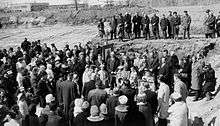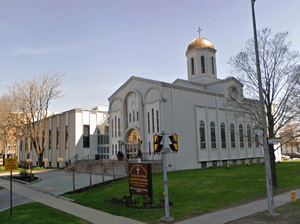St. Clement of Ohrid Macedonian Orthodox Cathedral, Toronto
| St. Clement of Ohrid | |
|---|---|
|
View of St. Clement of Ohrid Cathedral | |
| Location |
76 Overlea Blvd. Toronto, Ontario M4H 1C5 |
| Country |
|
| Denomination | Macedonian Orthodox Church |
| Website | stclementofohrid.com |
| History | |
| Founded | 1962 |
| Administration | |
| Diocese | American-Canadian |
| Clergy | |
| Pastor(s) |
Rev. Traiko Boseovski Rev. Ilija Dimitrieski |
St. Clement of Ohrid (Macedonian: Св. Климент Охридски) in Toronto, Ontario, is the first Macedonian Orthodox Church in Canada and one of the oldest in the American-Canadian Diocese.
History

Toronto is the home to the largest concentration of Macedonians outside of the Balkans, with estimates ranging from between 100,000 to 150,000 Macedonian Canadians.[1] Long before the Macedonian Orthodox Church was declared autonomous, early immigrants from Macedonia and their descendants founded churches that were under the jurisdiction of the patriarch in Bulgaria.[2] They were Sts. Cyril & Methody Macedono-Bulgarian Orthodox Church, founded in 1910, and St. George Macedono-Bulgarian Orthodox Church , founded in 1941. However after the Macedonian Orthodox Church declared autonomy in 1958, many members felt the need to establish a new parish under its jurisdiction. On 7 August 1962, members of the United Macedonians Organization held a meeting in the King Edward Hotel in Toronto and the decision was made to build a new church in the Thorncliffe Park neighbourhood which will bear the name of the medieval Saint Clement of Ohrid. After this decision was brought forth, an assembly was also formed and a church delegation was sent by the Holy Synod in Skopje, Macedonia. The first holy liturgy of the parish was carried out on 12 August 1962 in the "Zhelevo Hall", a community centre established by Aegean Macedonians from the village of Želevo (Antartiko). On 12 December of the same year, the church received its license from the city of Toronto to officially operate religious services. On 5 April 1964, the foundations of the church were laid by the church's first priest, Rev. Kiril Stojanovski. The event was also attended by Dositheus II, Archbishop of Ohrid and Macedonia. On 18 April 1965, on the Orthodox holiday of Palm Sunday, the church was officially opened for service.[3]
The Cathedral today
Today, the church not only tends to the spiritual needs of Toronto's Macedonian community, but it serves as the home to several prominent educational, cultural, and charitable organizations that actively preserve and promote Macedonian ethnic and cultural awareness. In addition to church services, St. Clement of Ohrid also has three banquet halls.[4]
In February 2009, on the occasion of the 50th anniversary celebration of the United Macedonians Organization, the church was visited by the Prime Minister of Canada, Stephen Harper.[5]
In August 2009, on the occasion of the Orthodox holiday of the Domition of the Virgin Mary, the church was visited by Nikola Gruevski - the Prime Minister of Macedonia.[6]
The inside of the church features murals by Macedonian/Canadian artist Georgi Danevski. [7]
Gallery
 The Iconostasis of the church
The Iconostasis of the church Interior of the church
Interior of the church- Icon of St. Zlata of Meglen
See also
- St. Dimitrija Solunski Macedonian Orthodox Church, Markham, Ontario
- St. Ilija Macedonian Orthodox Church, Mississauga
External links
Footnotes
- ↑ Gregory Michaelidis, "Salvation Abroad: Macedonian Migration to North America and the Making of Modern Macedonia, 1870-1970" (Ph.D. diss., University of Maryland, College Park, 2005),15.
- ↑ Lillian Petroff, Sojourners and Settlers: The Macedonian Community in Toronto to 1940 (Toronto: Multicultural History Society of Ontario, 1995)
- ↑ "Official Website of the American-Canadian Macedonian Orthodox Diocese". Retrieved 14 September 2014.
- ↑ "St. Clement of Ohrid Cathedral". Retrieved 14 September 2014.
- ↑ TJ-Hosting. "MHRMI". Retrieved 14 September 2014.
- ↑ "My Info Agent - All The Information You Need In One Place". Retrieved 14 September 2014.
- ↑ http://georgidanevski.com/
Coordinates: 43°42′31″N 79°20′28″W / 43.70857°N 79.34108°W
